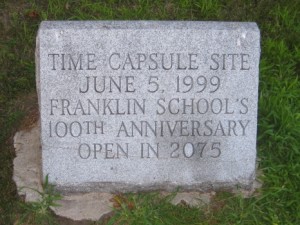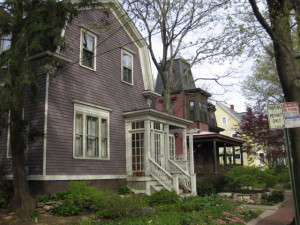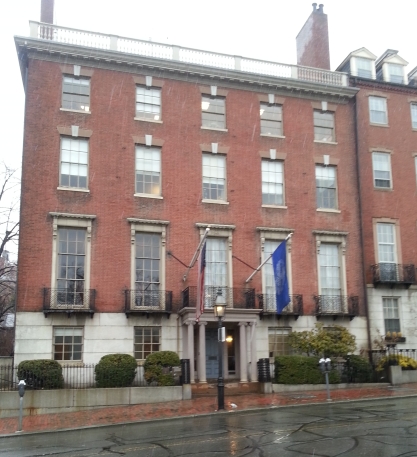Centers And Squares
Time Capsules in Medford and Watertown
Time capsules have been in the local news recently as two time capsules were unearthed in Boston. First, a 113-year old time capsule was removed from the head of the lion statue at the Old State House. Then in December an even older time capsule saw the light of day at the State House. This one was first secreted away in 1795 though it was rehoused and reburied in 1855. First deposited by Paul Revere, William Scollay and Samuel Adams, the capsule’s contents should be fascinating since so much time has elapsed and its creators played such a large role in our history.
Sometimes I think that time capsule creators don’t do that good a job of gathering evidence of their time. It’s difficult to decide what sums up an era – what will give people 100 or 200 years from now a real feel for our world. As a lover of old paper I’ve given this topic some thought over the years. Plenty of old paper I’ve got socked away brings back earlier times when I comb through the piles. For a time capsule perhaps a collection of essays in which people describe what they do in the course of a day would give a better sense of our lives. It’s the minutia of the day to day that will likely catch the fancy of people living in very different times.
I’ve come across a couple of time capsules in Centers and Squares territory. The one pictured above is in Watertown Square. It’s due to be opened in 2030, when Watertown celebrates its 400th birthday. I’m not sure how old the time capsule will be at that point – we’ll just have to be surprised! And I’m destined to forever wonder what’s in the time capsule outside the Franklin School condos in Medford on Central Ave, pictured at right, since it’s scheduled to be opened in 2075.
Preservation Month Events in Somerville
May is Historic Preservation Month and Somerville has a wealth of activities planned throughout the month. Here are some of them:
Tomorrow, Saturday, May 3, 2014, the Somerville and Cambridge historic commissions are teaming up to offer a walking tour of one of my favorite streets – Orchard Street. Somerville and Cambridge are considering nominating the Orchard Street neighborhood for the National Register of Historic Places. The walk starts at 10 am at the Porter Square Plaza on Somerville Ave across from the Porter Square T station
On Sunday, May 18, 2014 from 2 to 4 pm there’ll be a Walking Tour of East Somerville. “Identifying Architectural Gems from Gilman Square to East Somerville will be led by Edward Gordon of the Victorain Society in America. The tour will begin at the Somerville Public Library, 81 Highland Avenue.
Mark your calendars for the Somerville Historic Preservation Awards Ceremony held on Thursday, May 22, 2014 from 6:30 to 9 pm at the Somerville Armory, 191 Highland Avenue. A dozen Somerville property owners will be honored for their historic preservation work on the exteriors of their properties. It’s a great opportunity to hear about the transformations people have made with their rehab and restoration work.
On Wednesday, May 28, 2014 from 7 to 8:30 pm there’ll be a talk at the Somerville Public Library, 191 Highland Avenue, on “Researching the History of Your House and Your Family“. If you’re interested in local genealogy or the history of your old Somerville house you don’t want to miss this lecture.
For more information about any of the events you can contact the Somerville Historic Preservation Commission at 617-625-6600 x2532.
Historic Homeowners – This Group’s For You
Do you live in an old house? Chances are good that you do since so much of our local real estate was built before 1900. Old house owners should consider a Historic Homeowner membership with Historic New England. It’s one of several special interest membership categories and comes with a long list of member benefits. One that was invaluable for me was a historic paint color consultation done for my house by Historic New England’s Sally Zimmerman. Never would I have been able to choose those colors myself.
One of my favorite Historic Homeowner member benefits is the opportunity to tour vintage houses with fellow members and Historic New England staff. It’s a super opportunity to see very interesting privately owned houses and to get a close-up look at architectural details and restoration work – completed or in progress. There’s nothing like seeing the houses first-hand in the company of fellow old house enthusiasts and old house experts.
Last Fall, as a Historic Homeowner member, I had the opportunity to visit the Alanson Tucker House in Derry, NH, pictured above. It was an unforgettable experience. The house was built for Tucker, a successful merchant, in 1816 and the setting and the house retain an amazing amount of original detail. The owner, a Historic Homeowner member, is in the midst of a years-long painstaking restoration. It’s truly a case of a perfect match between house and homeowner. The owner’s deep knowledge of historic architecture means that he can read the telling details in the house that others might miss and can peel back layers added over the decades to reveal the house as it was almost 200 years ago.
The last two weekends I’ve toured two more properties with fellow Historic Homeowner members – one in Boston and one in Cambridge. Both of the houses are protected by preservation easements held by Historic New England.
Across from the Boston Common we visited the headquarters of the American Meteorological Society on Beacon Street, pictured below. 45 Beacon Street is the third house in Boston that architect Charles Bulfinch designed for Harrison Gray Otis. Built in 1806 it is here that the Otis family lived the longest. The first Harrison Gray Otis house on Cambridge Street is the headquarters for Historic New England. The second, on Mount Vernon Street is a private home and Beacon Hill’s only freestanding single family. Our tour was fascinating on many levels – the house is extraordinary, we learned much about Otis, one of Boston’s early developers, and as the daughter of a lifelong weather buff I appreciated all of the weather-related tidbits too.
Last weekend Historic Homeowner members were invited to tour a house built in North Cambridge in 1853 and restored by its long-time owner. The house is a blend of Greek Revival and Italianate styles and we toured it from top to bottom. It was a wonderful opportunity to see the architectural details up close with all sorts of insights shared by the homeowner and by Sally Zimmerman from Historic New England. My notes from our visit are filled with the names of companies and artisans who do quality restoration work of all sorts.
This coming weekend we’re off to see another house in the stewardship easement program. It’s a very early house in Brookline, built in 1683.
Don’t think that your house isn’t old enough for you to benefit from a Historic Homeowner membership. The program welcomes homeowners with more recently built vintage homes and previous member tours have featured mid-century modern houses.
If you want to do right by your old house the Historic Homeowner program is an invaluable resource – and great fun too for old house enthusiasts.
Houses Have Stories To Tell

Sometimes I look out the window of my old house and think about who stood here, looking out, decades ago.
Recently I made a point to vist an open house for brokers in Arlington Heights. The house was a beautiful Greek Revival, one of my favorite architectural styles, and I looked forward to seeing it.
I wasn’t disappointed. The house was filled with well preserved architectural details and a real treat to see. On the dining room table the agent had put out a number of pieces about the house’s history to share with buyers.
My favorite by far was a packet of letters that the homeowner had received from a member of the family that moved into the house more than a century ago. The letters were rich in detail about how the house looked decades ago and filled with stories about the author’s memories of her family and life over the years in the house.
The letters were mesmerizing – filled with tidbits that evoked the sights, sounds and smells of the early 1900s. I brought my mother a copy, knowing she would enjoy them as much as I did. “We’ve got to buy this house!” she exclaimed. “Let’s sell this one and move.”
That was not to be – the house sold that weekend to a someone more prepared than we were. But it was an example of how powerful sharing the stories of your house can be when it’s time to sell and pass the house on to new owners.
I love old houses and confess to sometimes feeling like an adopted member of the families that have lived in them before me. When it was time to sell my first house, a sweet little house circa 1865, I wrote a piece about what I had learned about the family that had owned it before me – just one family since it was new. My packet for buyers included vintage photos of the house that dated from the 1880s through the 1930s. It was important, I thought, to pass on that history, so the stories could be preserved for new owners. Several years later, when the house again exchanged hands, the vignette about the house was handed over to the next owners once again.
Chances are your house has stories to tell too. Whether you’re fortunate enough to have a former owner share memories with you, or you do the fun work of discovery through your own house history research, the stories your house has to tell can make you feel more connected to your old house.
When it’s time to move, make sure you pass on your house’s stories. You’ll be preserving history and may just hook a buyer at the same time.
Shirley Shaker Village

Shakers were buried in the Shirley Shaker Village cemetery from the 1700s to the 1920s. See more images in the slideshow below.
Recently I had the opportunity to tour the Shirley Shaker Village. The tour is only offered once or twice a year and I’d missed it more than once.
The Shaker Village in Shirley is on the grounds of the MCI-Shirley – the prison. It’s a somwhat surreal experience – the pastoral landscape, the historic buildings, and the minimum, medium and maximum facilities that surround you make for an odd juxtaposition and a rather unsettling feeling.
The Shaker community in Shirley had sixty residents by 1790. At its height in the mid-1800s there were 150 residents of Shirley Shaker Village. Their buildings were wood frame or brick and included a laundry, a meetinghouse, an infirmary, barns and shop buildings. In 1850 the Shakers built a cotton mill nearby on the Catacunemaug River. Many of the buildings are extant, others are no longer standing. The Meetinghouse was moved to Hancock Shaker Village in 1962 after its meetinghouse burned. On the site you can still see the walkways that led to the separate entrances for men and women.
By the early 1900s only three Sisters remained in the Village. They relocated to Harvard and the 900 acre property was sold to the state of Massachusetts. The State opened the Shirley Industrial School for Boys – a reform school – that operated on the site until it was closed in the early 1970s. Some of the Shaker buildings still have Colonial Revival details that were added during the early days of the Industrial School.
One benefit of the buildings being on the prison grounds is that the State doesn’t have the money to upgrade the buildings so they remain remarkably intact. That was true in Concord where I grew up – a variety of buildings around MCI-Concord were untouched by time – never having been subjected to unfortunate renovations. But, like Concord, which lost a number of its older buildings near the prison, several of the Shirley buildings are crumbling and are past the possibility of restoration. Other buildings have been restored or at least buttoned down with money from a grant that the Shirley Historical Society received.
Check the Shirley Historical Society website for announcements about touring Shirley Shaker Village. It’s a fascinating tour and not to be missed.
The slideshow from our tour is below. For some reason I seem to have photos of the brick buildings but not so many of the wood framed buildings. We had to be careful not to take any photos that included inmates, or border fences, or prison buildings so I wasn’t able to capture every view that I would have liked. The last couple of images are of the mill buildings that remain down the street and are currently used as commercial space.
House Moving in Belmont
The Boston Globe had a great article today about a house moving in Belmont on Saturday.
The Thomas Clark House, circa 1760, was built by the Clarks, a prominent family in early Belmont history. Sadly, the house had been bought by a developer who wanted to tear it down. After a public outcry, funds were raised to move the house.
Until yesterday, the Thomas Clark House could be found at 59 Common Street in Belmont, MA. Now it’s sitting – temporarily – near the high school on Concord Avenue until its fate is determined.
Here are more photos of the house on its Facebook page. It’s a good thing when a Colonial-era house gets a Facebook page!
And here’s a time-lapsed photo video of the move:
Diner Lecture at the Medford Library
I’m a big fan of diners – I like classic roadside architecture and the menu offerings. Happily, Massachusetts still has a good selection of classic diners with several in Centers and Squares territory.
Tomorrow night, Monday, January 23, 2012, Larry Cultrera will give a presentation at the Medford Public Library on Classic Diners of Massachusetts. Cultrera is a diner historian and his new book, Classic Diners of Massachusetts, has just been published by the History Press.
The Classic Diners of Massachusetts lecture is scheduled for 7 pm on Jan. 23, 2012 at the Medford Public Library, 111 High Street, Medford MA. Free and open to the public.
Tercentenary Signs In Massachusetts
The Boston Globe had a wonderful article on Sunday about the Tercentenary Signs you bump into around Massachusetts. The signs were erected in 1930 as part of the celebration of the tercentennial – Massachusetts’ 300th birthday by the Massachusetts Bay Colony Tercentary Commission.
The article is fascinating – I love the signs but hadn’t known a great deal about their history. (I’ll soon fix that – an article like this one puts me on a quest for more info – and a 1930 copy of Samuel Eliot Morison’s Historical Markers of Massachusetts is now heading my way courtesy of ABEbooks.com and a bookseller in Vermont).
Turns out that the research and text used on the signs was done by Harvard historian Samuel Eliot Morison and the Globe‘s article touches on how the signs are a reflection of what was considered important by Eliot and others from the vantage point of 1930.
Me? I’m just happy that we have any semi-permanent reminders of what happened here since our memory seems to get shorter and shorter.
While many of the signs have remained almost half are no longer in place. Happily there are efforts underway to restore the missing markers, according to the Globe, including a proposed bill to provide funds for restoration and replacement.
Next time you come across a tercentenary sign take a minute to read it and think about what once was not that long ago. Here are a few of the tercentenary markers from Arlington, Cambridge, Medford and Watertown.
Copyright © 2008 - 2011 Centers And Squares Agent Login Design by Real Estate Tomato Powered by Tomato Real Estate Blogs








